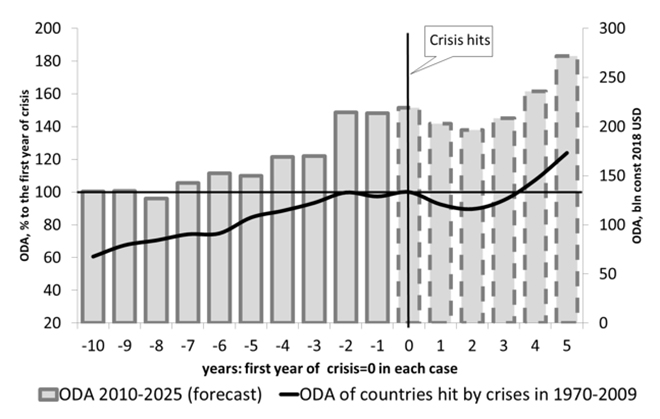-
CENTRES
Progammes & Centres
Location

The COVID-19 pandemic crisis has hit many developing countries hard and threatens the realisation of the UN Sustainable Development Goals (SDGs). The World Bank estimates that between 40 and 60 million people may be pushed into extreme poverty in 2020 as a result of pandemic, making it difficult to end poverty by 2030. Assistance provided by developed countries constitutes an important source for financing the needs and SDGs of weak economies, particularly for countries that have no access to international capital markets. However, most donors are facing deteriorating macroeconomic conditions, including economic growth, production output, employment rate, output gap, fiscal position and the amount of debt. Evidence shows that under the current adverse conditions, the governments of donor countries have redirected funds allocated for development assistance to the resolution of domestic issues.
Figure 1 depicts aid quantity indices ten years before and five years after a crisis against the first crisis year. Countries whose growth slowed during the 2008-09 recession are compared against mean value for countries, which exhibited slower growth during previous financial crises. The list of crises contains 30 cases of financial crises experienced by different countries in 1974-2000 and the recent financial crisis of 2008.
Figure 1: Forecast of Official Development Assistance after COVID-19 crisis
 Source: Authors’ calculations based on “Bilateral Official development Assistance: Impact of the Global Financial Crisis of 2008-2009”
Source: Authors’ calculations based on “Bilateral Official development Assistance: Impact of the Global Financial Crisis of 2008-2009”
Figure 1 demonstrates that during prior recessions, the Official Development Assistance (ODA) provided by countries hit by a crisis dropped on average by eight percent in the first post-crisis year and by ten percent in the second post-crisis year against the pre-crisis period. Moreover, ODA typically did not rebound until three years after the onset of a crisis. If the same logic is applied to the current trend, ODA will drop in 2021 and reach its pre-crisis level no sooner than in 2024. Especially worrying is the fact that during preceding crises, developing countries with upper-middle income were less susceptible to post-crisis changes in donor behavior, i.e. donors preferred to decrease aid quantity at the expense of poorer countries.
Given that COVID-19 is the most profound global crisis since the Great Depression of the 1930s, it will likely have a far stronger influence on development aid than what is suggested in studies of prior crises. Despite confirmations from donor countries that they will strive to protect their ODA budgets, bilateral aid commitments reported to the International Aid Transparency Initiative in the first five months of 2020 are about 30 percent lower than during the same period in 2019. Some of the largest donor countries have already announced international support measures in response to COVID-related crisis, but this is not sufficient to support recovery in low-income countries and to sustain pre-crisis ODA levels. First, some of the declared expenditures are in-donor expenses on vaccine development (for instance, reprioritisation of European Commission program Horizon 2020, funding to Canadian researchers’ and life sciences companies’ coronavirus research), which is impactful but should not be confused with ODA. Second, most of the announced contributions to international organisations are financing of the international efforts on the development of drugs and vaccines (for instance, investment in the development of drugs and vaccines by Japan and contribution of the UK to the Coalition for Epidemic Preparedness Innovation). Third, some projects are the result of refocusing existing resources (for instance, the redirection of German ODA budget to COVID-19-related projects, and the French emergency response project “Covid-19 – Health in Common”), which does not lead to an increase in total ODA levels, concentrates resources on emergency response and leaves other spheres such as basic healthcare and education underfinanced.
Slow and insufficient response to the COVID-19 crisis by traditional donors represents an opportunity for emerging powers such as BRICS to play a bigger role in the international development assistance framework. BRICS countries, especially China and Russia, have already shown a readiness to provide leadership on global issues and provide beneficial and well-timed international development aid. Thus, the New Development Bank (NDB) has approved the first NDB Emergency Assistance Program in Combating COVID-19 in March, and by now has provided loans to Brazil, China, India and South Africa, totaling US$10 billion. China and Russia have also taken some bilateral measures aimed at support of other developing countries. Russia has distributed COVID-19 tests, protective and medical equipment, medicine, medical personnel and directed funds to 46 countries around the world. Apart from bilateral aid, Russia made additional contributions to international organisations such as United Nations Development Programme, Red Cross and World Health Organization. In May 2020, China announced a US$2 billion aid package for other developing countries to be distributed in 2020-2021, the establishment of a cooperation mechanism of Chinese hospitals with 30 African hospitals, a debt relief programme, and promised to make any vaccine developed by China a global public good. Obviously, these measures are similar to humanitarian aid actions taken by traditional donors, and to take the leadership, BRICS should present a striking difference to other countries, including scaling up of resources, increasing effectiveness of development assistance and its transparency.
Thus, if traditional donors follow the historical trend and decrease their ODA volumes in the post-crisis period, it will seriously challenge the world’s ability to get on a sustainable development path in the near future. In this case, the BRICS nations, which often position themselves as representatives of emerging countries, have an opportunity to increase their role in global governance, although it depends on their ability to develop an ambitious agenda in development assistance sphere and show an example of effective and beneficial post-crisis development aid.
The views expressed above belong to the author(s). ORF research and analyses now available on Telegram! Click here to access our curated content — blogs, longforms and interviews.

Aleksandra Morozkina PhD lives in Moscow Russia. She is a head of the Structural Reforms Division at the Economic Expert Group and an associate professor ...
Read More +